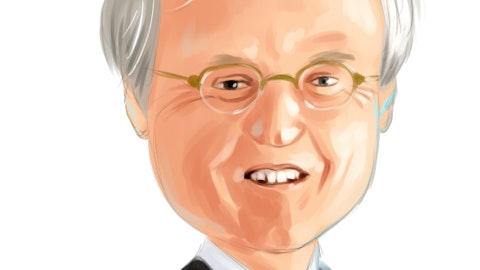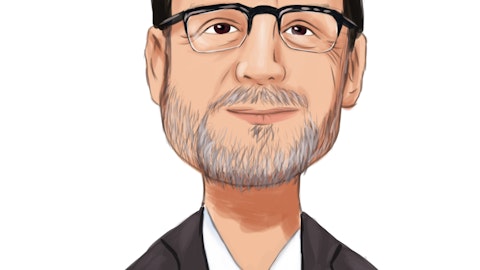Bank of Marin Bancorp (NASDAQ:BMRC) Q4 2022 Earnings Call Transcript January 23, 2023
Andrea Henderson: Good morning, and thank you for joining Bank of Marin Bancorp’s Earnings Call for the Fourth Quarter Ended December 31, 2022. I’m Andrea Henderson, Director of Marketing for Bank of Marin, and thank you for your patience this morning. During the presentation, all participants will be in a listen-only mode. After the call, we will conduct a question-and-answer session. This conference call is being recorded on January 23, 2023. Joining us on the call today are Tim Myers, President and CEO; and Tani Girton, Executive Vice President and Chief Financial Officer. Our earnings press release which was issued this morning can be found on our website at bankofmarin.com, where this call is also being webcast. Before we get started, I wanted to note that we will be discussing some non-GAAP financial measures on the call.
Please refer to the reconciliation table on Page 3 of our earnings press release for both GAAP and non-GAAP measures. Additionally, the discussion on this call is based on information we know as of Friday, January 20, 2023, and may contain forward-looking statements that involve risks and uncertainties. Actual results may differ materially from those set forth in such statements. For a discussion of these risks and uncertainties, please review the forward-looking statements disclosure in our earnings press release, as well as our SEC filings. Following our prepared remarks, Tim and Tani will be available to answer your questions. And now I’d like to turn the call over to Tim Myers.
Tim Myers: Thank you, Andrea. Good morning, everyone, and welcome to our call. We are pleased with our record fourth quarter and full year earnings. Both reflected the strength of our relationship banking model, paired with disciplined expense control, liquidity and credit risk management efforts. As always, we remain dedicated to disciplined underwriting and prudent lending. Origination fees in the fourth quarter for a $240 million in full year production represented the second best since 2019 without the need to compromise credit quality. In fact, we saw a steady derisking of credit portfolio over the course of the year. We are of course mindful of recessionary concerns and associated impact on loan demand. However, we will continue to rely on our balanced approach to meeting customer needs, while maintaining a strong credit culture in order to navigate any economic slowdown.
We provide exceptional service and local market expertise deepening ties with our customers without competing strictly on price or taking unnecessary risks. Although our loan balances declined modestly from the third quarter, we funded $35 million in commercial loans in early January 2023, that had been scheduled to close in the fourth quarter of 2022. $20 million of that is expected to remain on our balance sheet as we have participation commitments for $15 million of that total amount. Our asset-sensitive balance sheet helped our performance in 2022 driving yields on interest earning assets. And we will be diligent about protecting our net interest margin in 2023. More than half of total deposits were non-interest bearing at the close of 2022.
While our cost of deposits rose just two basis points in the fourth quarter, rising rates boosted our tax equivalent net interest margin by 10 basis points in the fourth quarter and 23 basis points over the fourth quarter of the prior year. Finally, earnings and synergies generated from our 2021 acquisition of American River Bank further contributed to our improved efficiency ratio, allowing us to allocate resources towards our strategic initiatives as we head into the new year. In Q1 2023, we will deliver on our plans to further gain efficiencies from the merger by consolidating four Northern Sonoma County branches into two that have overlapping customer coverage. Also in the quarter, we will close two additional branches where we will be able to serve customers effectively from nearby locations.
These efforts are expected to generate savings of $470,000 in 2023 and approximately $1.4 million per year thereafter that will be reinvested in both talent and technology. Now I’ll turn to some additional highlights. We produced record net income of $12.9 million in the fourth quarter compared to $12.2 million in the third quarter. Diluted earnings per share of $0.81 compared to $0.76 in the third quarter. For full year 2022, we generated record earnings of $46.6 million, up from $33.2 million in 2021. Diluted earnings per share were $2.92 for the quarter compared to $2.30 per share the prior year. Noninterest-bearing deposits accounted for 51.5% of total deposits at the close of the year, down slightly from the third quarter, but our average cost of deposits remained very low at just 8 basis points.
While the market anticipates interest rates will climb further in the first quarter, we will continue to carefully manage deposit pricing on a customer-specific basis. Credit quality, as I noted, is strong and improving. With fourth quarter nonaccrual loans declining $8.2 million or 77% in the fourth quarter and representing only 0.12% in total loans down from 0.49% at September 30. Our efficiency ratio for the fourth quarter was 50.92% compared to 52.24% for the prior quarter and 56.92% in the fourth quarter of 2021. The improvement was driven by lower operating expenses and higher net interest income on both loans and securities. Given the consistency of our performance and record earnings, our Board of Directors declared a quarterly cash dividend of $0.25 per share payable on February 10, 2023.
This represents the 71st consecutive quarterly dividend paid by Bank of Marin Bancorp. Now I’ll turn the call over to Tani to discuss our financial results in more detail.
Tani Girton: Thank you, Tim. Good morning, everyone. We are proud of our fourth quarter earnings, which translated into a return on assets of 1.2% and return on equity of 12.8%, up from 1.1% and 11.7% in the third quarter. Net interest income of $33.4 million in the fourth quarter increased $343,000 over the prior quarter as higher yields more than offset the 2.2% sequential decline in earning assets and the 2 basis point increase in cost of deposits. For the full year, net interest income was $127.5 million, up 21.4% from 2021 as a result of higher earning assets generated from the acquisition, as well as deposit growth in 2021 and lower funding costs primarily related to the early retirement of subordinated debt in 2021. Loan balances were down 3% in the fourth quarter as $55 million in payoffs consisting largely of real estate asset sales and cash paydowns more than offset new production of $36 million.
Deposits were also down in the fourth quarter, decreasing by $329 million or 8.4% from the prior quarter. While some of the decline can be attributed to our commercial customers’ year-end activity and specific planned events, we have been anticipating outflows of pandemic surge deposits for some time. At the end of 2021, the bank held $521 million in cash and deposit network balances in anticipation of expected and potential unexpected outflows. Over the course of the year, those balances as well as $112 million in borrowings and $164 million reduction in loans financed deposit outflows and growth in the securities portfolio. Our fourth quarter tax equivalent net interest margin improved 10 basis points, driven by the higher yields on interest-earning assets, partially offset by a 6 basis point increase in our cost base interest-bearing liabilities.

Adam Gregor/Shutterstock.com
There was no provision for credit losses on loans in the fourth quarter compared to a provision of $422,000 in the third quarter, an increase in qualitative risk factors to account for the ongoing deterioration in the economic outlook not captured in the quantitative portion of the allowance was offset by the decrease in loan balances. Fourth quarter noninterest income of $2.6 million was down slightly from the third quarter, mostly due to the reduction in fee generating deposit network balances. 2022 noninterest income decreased — sorry, increased $773,000 over 2021 due to higher fees on balances held at deposit networks and more transaction volume due to the larger size of the bank. Those increases were partially offset by the reduction in earnings on bank-owned life insurance.
Noninterest expense of $18.3 million in the fourth quarter was down $368,000 in the third quarter. Decreases from the prior quarter included a $957,000 reduction in salaries and employee benefits, largely due to a bonus accrual adjustment and an increase to the discount rate applied to retirement plans. In addition, other real estate-owned expenses declined due to a $345,000 valuation adjustment in the prior quarter. Full year noninterest expense increased $2.6 million over 2021 as a result of our larger size investments in software and equipment, the valuation adjustment on real estate owned and accelerated costs associated with upcoming branch closures. Those increases were partially offset by the $5.6 million reduction in pretax merger-related and conversion costs.
We continue to reap the positive benefits of operating leverage as our efficiency ratios were 50.9% and 54.4% for the fourth quarter and full year, respectively, both improved from 52.2% in the prior quarter and 63.1% in 2021. As there were substantially more acquisition-related expenses in 2021, the year-over-year improvement on a non-GAAP basis was 374 basis points. All capital ratios were above well-capitalized regulatory requirements. The total risk-based capital ratio for Bancorp was 15.9% at December 31, compared to 15.1% at September 30. And the bank’s diluted based capital ratio was 15.7% at December 31 compared to 14.7% at September 30. Year-end tangible common equity of 8.2% for Bancorp and 8.1% for Bank of Marin were up 76 and 85 basis points, respectively, from the prior quarter due to the decrease in after-tax unrealized losses on available-for-sale securities associated with interest rate decreases during the fourth quarter as well as the contribution from our strong earnings.
Overall, Bank of Marin’s strong balance sheet, liquidity and capital continue to yield healthy results as has been the case across many interest rate and economic cycles. We believe that this will continue in 2023, enabling us to further invest in our strategic initiatives that will further improve profitability and strengthen our franchise. With that, I’ll turn it back over to Tim to share some final comments.
Tim Myers: Thank you, Tani. Our performance throughout 2022, combined with our more than 30-year history of delivering attractive returns to our shareholders in all cycles positions Bank of Marin well for the year ahead. We remain highly focused on diligent expense control, prudent risk management and proactive balance sheet positioning. Yet, we also continue to explore new ways to invest in technology upgrades and talent ensuring we can meet both meet clients’ increasing preference for advanced digital banking tools and high-touch service backed by well-established bankers of proven market expertise. We are committed to our existing clients and continuing to expand our commercial lending to new customers across Northern California, building on the American River Bank acquisition.
As we further optimize our delivery channels, we will continue to identify cost-saving opportunities to offset new investments we make, which are exceptional delivery of products and services throughout our footprint. With that, I want to thank everyone on today’s call for your interest and support. We will now open the call to your questions.
Operator: Thank you. We’ll proceed with our first one on the phone from the line of Matthew Clark from Piper Sandler. Go right ahead.
See also 15 Stocks That Have Increased Dividends for 25 Years and 12 Biggest Cloud Providers by Market Share.
Q&A Session
Follow Bank Of Marin Bancorp (NASDAQ:BMRC)
Follow Bank Of Marin Bancorp (NASDAQ:BMRC)
Matthew Clark: Good morning, Tim, Tani.
Tim Myers: Good morning, Matthew.
Matthew Clark: Maybe first just on your updated thoughts around your deposit beta this cycle, interest bearing deposit beta of only 1% cycle to date. I think on the last call, you spoke about maybe getting towards 20% through this cycle. It seems like you might do a lot better than that at this stage, assuming the Fed’s done here in the first half of the year. Just any commentary around your thoughts around deposit pricing in light of the decline in deposit balances as well.
Tim Myers: Yes, so I’ll start Matthew and then I’ll hand it over to Tani. But bigger picture, if you look at the biggest chunk of deposit runoff both on a year-over-year basis and quarter, it was accounts tied to our – what we call business as usual, we had outflows from accounts side to election cycles and things like that. We did have some runoff in a couple of key client areas where they manage money for other people, where they were looking a higher yield and went to alternative investment vehicles. Very little of the amount we lost both quarter and on a year-to-date basis, we’re losing money to other financial institutions relative to the total. But that can change as the rate environment changes and rate increases further. I’ll hand it to Tani for more of the specifics.
Tani Girton: So our model beta on the interest bearing deposits is 34%, but historically we’ve achieved less than that, but because we have about 50% of our deposits in non-interest bearing. Obviously, the total beta is going to be roughly half of that. And I’d say, I would just reinforce what Tim said, we’re really proactively reaching out to customers when rate concerns come up and making sure that we’re addressing them on a full relationship basis as opposed to raising rates across the board. We have a significant amount of liquidity, contingent liquidity that we have not tapped into for many, many years. And so that enables us to really be thoughtful about how we manage our cost of deposits.
Matthew Clark: Okay. And then just to round out the margin discussion. If you have it, the spot rate on interest bearing deposits at the end of the year and the average margin in the month of December?
Tani Girton: Let me pull those for you and come back to you on those.
Matthew Clark: Okay.
Tani Girton: You want December 31 rates, is that right, for the month of December?
Matthew Clark: Yes, the spot rate at the end of the year or at the end of December on total deposit costs or interest bearing other one, and then the overall average NIM for the month of December if you had it?
Tani Girton: Okay. Yes, I’ll come back on that. I have to shuffle some papers.
Matthew Clark: Okay, no worry.
Tim Myers: Thank you, Matthew.
Matthew Clark: Yes, and then just on the buyback, there’s some mention in the release about reconsidering – reinitiating the buyback. I guess can you give us a sense for what’s changed other than rates? Capital obviously is up with the benefit of rates, but any other color there would be helpful?
Tim Myers: Yes, we want to be prepared, Matthew. We think at this valuation, it’s really attractive for us to buy back stock. We have to continue to watch trends in the economy and credit risk and for other potential impacts on capital. But we don’t want to be boxed into not doing it. We want to have the ability to do that and it’s something we talk regularly with the Board about.
Matthew Clark: Okay. And then last one from me. Just on your office exposure, could you just remind us the outstandings there and the kind of split between downtown metro office relative to rural and what you’re seeing there in terms of the impact of ongoing tech layoffs and how that exposure might perform over the coming months?
Tim Myers: So as of December 31, we had about $450 million in total office commercial real estate. The loan to value based on the most recent valuations we have on file and obviously that changes all the time is just under 44%. San Francisco is $82 million of that. That loan to value is the same. So we have good cushion and we are proactively working with borrowers where we think there is significant exposure to that environment you’re alluding to and reevaluating those properties. So, we haven’t really seen the trends materially worsen for our portfolio. We’re not lending to the Salesforce Tower buildings of the world, but that – as a fact other properties. But that loan to value is pretty consistent throughout all the various submarkets.
So we have again, valuations change, but we proactively do that and we have properties, we have concerns on. But that that gives us significant cushion to work with those borrowers. And in the vast, vast majority cases, we have sponsorship behind those and work closely with them to make sure we stay on track for repayment.





